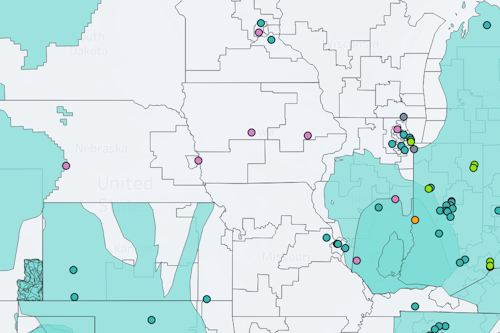User Guide to the 2020 Carbon Capture, Use, and Storage Map

In 2017, Third Way released a ground-breaking interactive map that let users see exactly where carbon capture, use, and storage (CCUS) projects were happening around the globe. In 2018, after refining our methodology and expanding our criteria, we updated the map to show 300 projects worldwide. Keeping our finger on the pulse of CCUS over the past two years, we’re back with a revamped version of the Carbon Capture, Use and Storage Projects Map. Our new product retains the same goals and criteria used in 2018 but adds layers of specificity and interactive features designed to make it more useful to policymakers and advocates. This memo can help guide users through the features of the new map, the accompanying projects database, and the methodology behind both.
Caption
Map View
Map users now have the option of viewing a United States-only window or a window with projects across the globe.
Map Layers
We have refined our map layers to provide groupings that we think will be important for data users. First, one can use our map to examine all of the oil and gas reservoirs and saline sandstone basins where carbon dioxide (CO2) can be sequestered. In the former case, CO2 can be stored in defunct underground oil wells or gas reservoirs that have reduced or ceased production. Often, enhanced oil recovery (EOR) – the process of extracting oil using CO2 – precedes permanent storage. In the latter case, the map shows where CO2 can be directly injected into rock formations thousands of feet below the surface for permanent sequestration. It is important to note, that oil and gas reservoirs and saline basins represent possible locations for storage but do not necessarily reflect whether CO2 is currently being stored there. Finally, at the request of policymakers, we added a “Congressional District” layer to the area of the map covering the United States.
Project Types
As in the previous two iterations of our map, we divide carbon capture projects into six major applications: Power Generation, BECCS, Industrial, Direct Air Capture, Carbon Use, and Test Centers. Four of the applications (Power Generation, BECCS, Industrial, and Test Centers) focus on capturing CO2 from point sources where it is emitted. Specifically, Power Generation denotes projects that capture CO2 from electricity-generating facilities; BECCS refers to Bioenergy with Carbon Capture and Storage, or those facilities that either burn biomass (plant material) to create electricity or make biofuels; Industrial facilities capture CO2 during the manufacture of cement, steel, chemicals, glass, and other industrial products. Test Centers are eponymously named research facilities that specialize in carbon capture research, or they are part of the International Test Center Network (ITCN). Direct Air Capture (DAC) projects remove CO2 from ambient air, and the last category, Carbon Use projects, are facilities that make products in part or completely from captured carbon dioxide. The fact that this map includes carbon uses sets it apart from other excellent resources that outline carbon capture work across the world or the United States At the bottom of the United States map view, there are six background maps that each correspond to one project type. Clicking on one of those six background maps will allow a user to quickly view only projects of that type across the country.
Project Status
In the bottom left hand corner of the map, we use color coding to indicate the status of each project, with five possible status options. “In Planning” represents projects that have secured investor funding and have been announced publicly but have not commenced construction. “Pilot” projects are small-scale studies that operate for a fixed duration of time and are meant to test the feasibility of using the same technology on a much larger project that would operate indefinitely. “Pilot-retired” are pilots that have run for their designated testing period and have been shut down. “Construction” denotes that the project is being built. “Operational” is the last status and signifies commercial projects that are currently operating.
Selecting a Specific Project
As shown in the photo below, when a project is selected on the map, an information bubble pops up with the project name, city, Congressional district (for US-based projects), carbon storage or utilization rate, and a link to an external webpage with additional project information. We added carbon storage/utilization rate this year in metric tons per year (tpy), where applicable, to help quantify and compare the emissions reduction of a facility or the amount of carbon sequestered in a product made from CO2.

Projects Database
Our map is accompanied by a projects database that lists all project information in a web-based spreadsheet. The first worksheet is a list of all projects across the globe, and the second contains just those found in the United States. Projects can be sorted by project type, country, state or province (where applicable), city, Congressional District (for U.S. projects), the latitude and longitude of the project location, project status, or the rate of CO2 capture, utilization or storage. There is a column containing a one-sentence description of each project, and another providing URLs for external webpages.
Methodology for selecting projects
To be included in this map, a project must either be capturing or using CO2 beyond bench scale operations or have publicly announced that they are planning such a project. This criterion necessarily means that not all research facilities and companies engaged in basic and applied CCUS research are included in this map. We recognize that our selection occasionally involves subjective judgment about the activities of private, for-profit companies. However, we have made every effort to accurately depict the global CCUS landscape. We will continue to stay abreast of all happenings in the CCUS universe and encourage viewers to contact us with project updates.
Subscribe
Get updates whenever new content is added. We'll never share your email with anyone.
